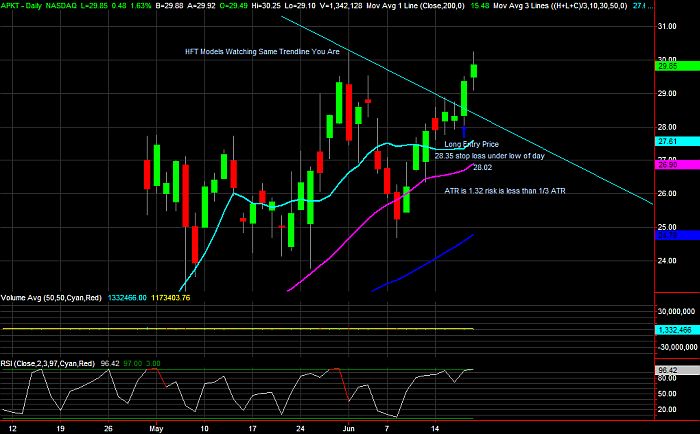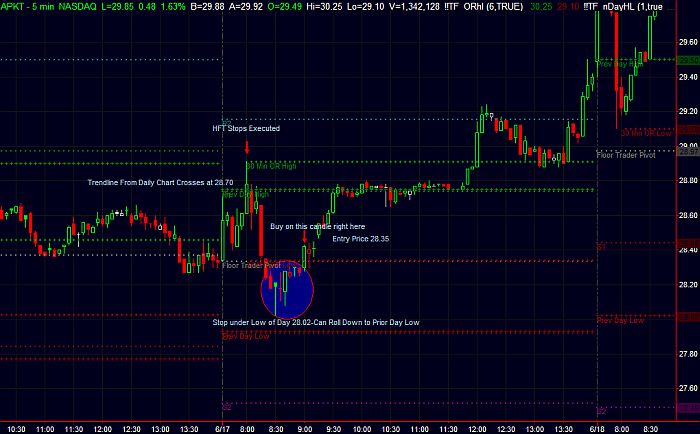 Today's guest, Michele (Mish) Schneider has gotten such a phenomenal response from Trader's Blog readers in the past, that we've decided to bring her back and share her take on High Frequency Trading, or HFT, plays. You can leave any questions or comments here on our blog, but be sure to visit Mish on her site, Market Gauge, as well.
Today's guest, Michele (Mish) Schneider has gotten such a phenomenal response from Trader's Blog readers in the past, that we've decided to bring her back and share her take on High Frequency Trading, or HFT, plays. You can leave any questions or comments here on our blog, but be sure to visit Mish on her site, Market Gauge, as well.
-------------------------------------------------------------------------------------------------------------------------------
Not too long ago, the buzz around the street was all about High Frequency Trading Models and the possible legislation that would be enforced to try and quell them. What is High Frequency Trading (HFT)? According to an interview with Sal Arnuk Partner of Themis Trading LLC printed June 14th, 2010 in the High Frequency Trading Review—yes, there is such a publication—“I guess you can call HFT any strategy that involves high speed execution of thousands of orders per second, or in a short time period. I don’t even want to handicap it by calling it thousands as some people can do a million.”
According to Wikipedia “In the U.S., high-frequency trading firms represent 2% of the approximately 20,000 firms operating today, but account for 73% of all equity trading volume.”
To date, there has not been legislation passed curtailing firms from HFT and the debate continues. We as traders do not need to participate in that debate, but rather understand that it exists and there are ways to identify when the HFT prints are occurring, thereby adjusting your trading strategy. When I traded as a commodities floor trader, our job, in essence, was to know where the larger resting orders were, run the market up or down to trigger them, and then sell into the rally or buy into the dip. Now that we trade electronically, we know we cannot beat the HFT computers of firms like Goldman Sachs. Therefore, we first learn to identify when prints are occurring that force the market artificially low or high and go against the rhythm and the main trend of any particular stock or index. Then, once you can distinguish when this recurs, you can wait until it reverses thereby taking advantage of these false types of prints.
Here’s a strategy to make out when the HFT algorithms are in play to find good trading opportunities and avoid buying false breakouts/breakdowns.
Step 1 is to pick out stocks that are strong. Today’s example, APKT is perfect. It made new highs on June 1st, 2010, and then retreated when the market came under pressure in the subsequent days but remained strong in a bullish phase.
Step 2 is to buy weakness in a strong stock on an intraday basis and allow yourself to place really tight stops to reduce risk to virtually the lowest possible risk you can have. In APKT, there were several opportunities to get long. We are showing you the trade on June 17th as APKT came back over the 10 day moving average and consolidated for 4 days. We drew a trend line on the daily chart coming down from the recent high. That was a heads up that the stock would attract buyers once the trend line was penetrated and more than likely attract HFT buy orders.
Step 3 Once the HFT computers push a strong stock temporarily and artificially low by gunning a key reference point, we like to use the 30 minute Opening Range low. Orders often bunch up at the OR low. If the HFT models can see this, they will trigger the stops underneath that low, clean out the stops, a new low is made and then, we look for the reversal. Basically, what was once the domain of floor traders is now the domain of these HFT computers. Looking at the intraday chart of APKT, on June 17th, it crossed the trend line, took out the previous day high and sold off. It broke the floor trader’s pivot and the 30 min OR low. Sell orders were triggered and within 15 minutes, APKT spiked lower, making a new low (not taking out prior day low) and then bounced back.
Step 4 is to look for the reversal using a simple technique with a 5 minute candle stick that has its first positive close back above a key reference point such as a 30 minute OR low. In APKT, I’ve highlighted where the stops got triggered underneath the OR low. We bought APKT once it crossed back over the floor trader pivot and back above the 30 minute OR low. Our stop was now the low of the day. We got long a strong stock, after the HFT finished selling, against a great reference point and with an extremely low risk (around 1/3 of the Average True Range.) Notice how the rest of the day went. APKT proceeded to rally, taking out the trend line and closed on new highs.
If you've been searching for a way to make HFT and algorithm trading work for you rather than defeat you, this strategy is highly effective.
Best of luck,
Michele (Mish) Schneider
Market Gauge
-------------------------------------------------------------------------------------------------------------------------------
Michele (Mish) Schneider is a:
* Former Member/Trader of Coffee, Sugar and Cocoa, NYMEX and COMEX in NYC
* Former Market Analyst for Continental Grain
* Former Floor Analyst for Conti-Commodities
* Current Analyst, Producer, Writer, Newscaster for Mish's Market Minute
* Current Trader/Partner in Picatinny Partner's Hedge Fund
* Co-Author of the Complete Swing Trading System
* Director of Trading Research & Education for MarketGauge
* M.S. Special Education C.W. Post/Long Island University
For more from Mish be sure to visit her at Market Gauge.



Sorry guys, but I do not beliave this system works good. Everybody choose its own way of trading, but as to me to make trade really profitable it should be not complicated at first and should not have many indicators. All information is outlined in just candles and its setup, from where you can extract pivots and swings, tops and bottoms, and in addition using MacD and Stoch for conforming pullbacks. - this simple system works 99.9% accurate, because its easier to read- which means you will not lose your self.
Best regards to all traders and hallo to Adam for his excelent informative videos.
Best regards.
Thanks for your post. I found it very interesting and you couldn't have picked a better time to share your tips!
You said you used a tight stop with a 1/3 ATR. What were the number of periods used to calculate the ATR and was this an ATR based off the 5 minute chart?
Thanks again
Justin Miller
Hi Justin,
I use an average true range measured over a 10 day period. The ATR is what I use to measure entries, risk, targets and trading timeframe-daytrade, miniswing or swing trade. I have it automatically calculated on my customized TradeStation Package.
This strategy has worked great for us. Thanks for your comment.
Mish
Thanks again!
Between the HFTs and the Fed and the Treasury and the Market Makers,
all manipulating the market (primarily using the dollar), gaps up / gaps down,
gunning the reference points, stopping me out before profits,
investing has become a real pain in the butt.
Can't buy and hold anymore because the brokerage advisors won't advise when
to sell at the top of a market.
Day trading without the powerful computers takes a lot of skill and ability.
So us working blokes are better off using a swing system like MC or some of
the others systems shown in the video library.
Again, thanks Adam for setting up Market Club, it really helps me.
Mish at MarketGauge... What a service!!! Being introduced to MarketGauge since Oct '09 their systems and webinars have allowed me to see the BIGGER PICTURE. I believe anyone can learn to use scanners and finally pick good stocks. But, Michele brings the entire trade to you. Setup, Entry, Risk and Profit levels. She walks you thru her nightly watchlist with MG's Swing Trade program which is completely laid out to learn from.PDF's of the trade plan as guides. During her Twitters you follow along and can even get accustom to predicting the correct moves ahead to continue to teach yourself. And if you get crossed up she will keep you straight. Her service is the "REAL DEAL" to make yourself better and better. MarketGauge has a great way to teach you about std indicators and how to use them.
Tod,
Thank you so much for the acknowledgement!
Mish
Dear John,
What strikes me about your comment is that you seem to know yourself as a trader in that you like a mechanical system for finding swing trades. At Marketgauge, we have designed systems that are automated based on our swing trading strategies. Personally, I am a hybrid trader in that I use the "system" but prefer to be the "Operator" of those systems so I can adjust according to the overall market conditions.
Thanks for reading my post.
Mish